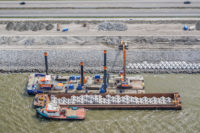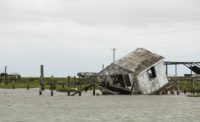Rising sea levels, as well as droughts and earthquakes, threaten the levees protecting the Sacramento-San Joaquin river delta, which supplies 25 million Californians with fresh water. But the state’s solution isn’t to build higher but lower—150 ft below the earth.
 California’s Dept. of Water Resources plans to dig two gravity-fed, 40-ft-dia tunnels under the delta to move fresh water from the Sacramento River to federal pumping stations in the southern delta. First proposed in the 1960s as a peripheral canal skirting the delta, the $15.7-billion delta tunnel project received an environmental certification from the state in late July.
California’s Dept. of Water Resources plans to dig two gravity-fed, 40-ft-dia tunnels under the delta to move fresh water from the Sacramento River to federal pumping stations in the southern delta. First proposed in the 1960s as a peripheral canal skirting the delta, the $15.7-billion delta tunnel project received an environmental certification from the state in late July.
“We’re engineering for a 200-year storm event in the delta, plus another 18 inches for sea-level rise,” says John Andrew, DWR’s assistant deputy director. “We’re figuring 55 inches in sea-level rise at the Golden Gate in the next 100 years.” With that amount of sea-level rise, saltwater would be pushed into the delta.
To avoid saltwater intrusion and reduce reliance on the delta’s 1,100-mile levee system, the proposed California WaterFix project would draw water from the Sacramento River in the north of the delta. The system could divert up to 9,000 cu ft of water per second into about 43 miles of tunnels to a new pumping plant on the delta’s southern edge.
To excavate the massive tunnels, contractors would send tunnel-boring machines down deep shafts, dug through the delta’s peat layers and into dense deposits of silts, sands and clay. Engineers adopted a twin-tunnel system, since constructing a single tunnel capable of conveying up to 9,000 cfs would require a machine larger than any currently used—60 ft or more in diameter.
Further, tunnel construction would require supporting infrastructure across the delta, including new roads and power lines, barge access to delta islands, and the removal or relocation of gas and water wells. The DWR estimates 12 to 15 months to staff the project, four years to complete the design and about 13 years for construction. The state expects to send out RFPs to tunnel designers and pump designers this fall, as well as begin selection of a firm to act as engineering-design manager, says John Bednarski, engineering manager at the Metropolitan Water District of Southern California.
WEST COAST For every foot of global sea-level rise caused by the loss of ice on West Antarctica, seas will rise approximately 1.25 ft along the California coast.
Lawsuits by fishing and environmental groups, however, threaten the project’s timeline. The Natural Resources Defense Council, Defenders of Wildlife, Bay Institute and Golden Gate Salmon Association say the proposed tunnel system would shunt high-quality Sacramento River water to Southern California customers and Central Valley farmers before it ever reaches the delta, endangering the region’s fish and wildlife. Water officials contend that the proposed WaterFix, along with the current system, would protect the fragile ecosystem and allows the DWR to gulp more water during large storms and sip less during droughts.
“Right now, we rely heavily on those delta islands staying intact and levees holding. But we can’t depend only on levees,” DWR’s Andrew says. “We expect not only rising seas. We expect extreme floods.”
Along the coast, San Francisco grapples with the same tidal forces. The city has put a $350-million bond issue on the November 2018 ballot to start improving its decaying 100-year-old seawall. Upgrading the three-mile, waterfront-supporting stretch would take decades and cost about $5 billion, says Steven Reel, project manager at the Port of San Francisco. And like the delta levees, the wall’s crumbling infrastructure and weak, muddy foundation leave it vulnerable to an earthquake.
“We need to look at these projects in a holistic way. This planning effort will look at both seismic risk and sea-level-rise plans over the next 50 years,” Reel says.




